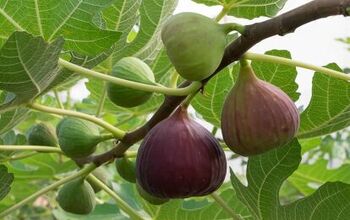How To Prune Roses In The Summer (Quickly & Easily!)

With the appropriate care, roses can easily be the crowning glory of any garden. But as most gardeners will tell you, coaxing a rose bush to full bloom is a delicate task. And getting a rose bush to thrive year-round is another matter, whether you have knockout, climbing, or hybrid tea roses. But if you respect the process, caring for your rose bush can be as rewarding as it is demanding.
The secret to growing a healthy and vibrant rose bush lies in understanding your plant’s needs. For starters, all plants require regular watering, fertilizing, and pruning. Since rose bushes bloom in the summer, the more intensive pruning will usually occur in the spring. For summer pruning, you will only need to lightly “deadhead,” remove dead wood, and form the bush.
To prune roses in the summer, first find a healthy shoot that has already bloomed. Identify the five-leaf cluster, which tells us where the cane is thick enough to support another stem. With your pruning shears, cut just above the five-leaf cluster, keeping it intact. Although rose varieties differ, you can expect your rose bush to be in full bloom 3-4 weeks after a light summer pruning.
Do You Need Landscaping Services?
Get free, zero-commitment quotes from pro contractors near you.

Pruning Roses in Summer
How do you prune roses in summer? Gently! Experts advise against any significant pruning in the summer months. Once a rose bush has entered its growth stage, careless pruning can expose your plant to disease and other elements. But when exercised correctly, summer pruning can promote late blooms, even into mid-August.
Don’t forget! Before beginning, water your rose bush to avoid any heat stress during pruning. Prepare a sanitary solution of 1 part bleach to 10 part water. Sanitizing the pruning shears is a crucial step to stop the spread of disease from plant to plant. Make sure to dip the shears into the solution before and after cutting each bush.
Tools Needed
To prune roses, all you will need is a pair of pruning shears and heavy gardening gloves.
Step One: Find a Healthy Flower
First, find a shoot with flowers that have already bloomed. Check that the shoot is healthy and free of disease. Discard any canes with black spots or any canes that are black, gray, or even dark brown.
Step Two: Look for Five Leaves and Cut Above
Find a cluster of five leaves. A five leaflet leaf set indicates where the cane is strong enough to carry another long stem bloom. With your pruning shears, make an angled cut ¼” above the five-leaf cluster. Clipping at a 45-degree angle allows water to run off instead of collecting.
Step Three: Remove Any Dead Blooms
Clip away any spent or dying blooms. By removing spent flowers or “deadheading,” you can stop the spread of disease among your roses. Since roses are especially susceptible to disease, it’s good to check regularly and remove any dying parts of the plant before the infestation spreads.
Keep the area around the base of the rose bush clear of debris. Spent blooms and small branches may seem harmless, but these materials become a breeding ground for powdery mildew or black spot.
Step Four: Cut Away Small Branches
Cut away any branches that are smaller than a pencil and any branches that rub against each other. Remove dead or dying branches by clipping at a 45-degree angle. Healthy shoots are green, red, orange, or brown. Dead shoots will be darker brown or black.
Step Five: Remove Rose Suckers
Identify any sucker canes growing from the ground. Sucker canes may appear as a regular cane, but instead of growing from the grafted bud union, sucker canes come out of the ground below the rose bush and drain the nutrients from your rose bush’s rootstock.
To remove sucker canes, follow them down to the root. Often, you will have to move the soil back to see the point where the sucker connects with the roots of your rose bush. With your pruning shears, cut the cane as close to the root as possible and seal with a tar-based product. Tree Wound Sealer is always reliable, but children’s school glue works as well.
Step Six: Shape Rose Bush
Here’s the fun part! Although you may not get many more blooms after a summer pruning, you can still set up for next year. Shape your rose bush as desired, removing up to ⅓ of the volume. Cut away any stragglers.
Parts of a Rose Bush
Cane
The cane is like the “tree trunk” or backbone of the rose bush. Sturdy and robust, the cane grows from the plant’s base and supports the long stems of the roses.
Grafted Bud Union
On a grafted rose bush, the bud union looks like a hardy knot, or knuckle, sitting level with the soil. The canes grow out of the bud union.
Suckers
If left untouched, suckers will divert all the nutrients from your rose bush and leave it to die. Rose suckers can be tricky since they look similar to canes, but a sucker has fewer leaves and may differ in color.
If you suspect a new cane is a sucker, follow the new growth into the ground. An actual cane will be protruding from the grafted bud union flush with the ground. A sucker cane will likely be protruding from the ground underneath the bud union, which is a good indication that it is sucking up all your nutrients.
Understanding Your Rosebush
A huge part of properly caring for your rosebush is understanding the commitment. Roses are considered a high-maintenance plant, but don’t be discouraged! With the proper knowledge, anyone can grow this beautiful and sensitive flower.
Roses need plenty of sun, lots of water, and good drainage. Since roses are susceptible to a range of diseases, clip away dead blooms and keep the soil area clear. Check for black spots and powdery mildew regularly. Keep an eye out for sucker canes and cut them away as they come up.
Water
Roses should be evenly watered throughout the summer and growing seasons. How often you water your plant will depend on your climate and soil, but a general rule of thumb is to water roses when the top layer of soil is dry. Water carefully and thoroughly, allowing it to soak in.
Avoid wetting the foliage when watering, as it could lead to rot. Water the root of your plant gently and from close range. Use a soaker hose or a watering pail with a longer spout.
Sunlight
For the best flowers, rose bushes should have 6 – 8 hours of sunlight each day. That’s an entire workday! Keep in mind that in hotter climates, you should keep your roses out of the direct sunlight during the hottest part of the afternoon.
Fertilizer
Roses, like all plants, need phosphorus, nitrogen, and potassium to thrive. You should fertilize Roses evenly and regularly throughout the growing season. When it comes to fertilizing around summer pruning, use a slow-release fertilizer to help prepare for next year’s growth. Stop 6 – 8 weeks before the first frost.
Sanitize
To avoid transferring diseases between rose bushes, sanitize your shears regularly. Use a mixture of 1 part bleach to 10 parts water. If parts of the rose bush show signs of disease, sanitize your shears after cutting them away and before moving on to another part of the plant.
The Importance of Pruning
Pruning is a fundamental and essential part of growing roses. The process removes dead blooms and promotes new growth. It’s vital for modern varieties of roses to thrive and bloom all summer long. You need to prune your roses to rid your plant of disease.
The Importance of Timing
Although pruning is necessary, it can be detrimental to your rose bush if done at the wrong time. The best time for heavy pruning is when your rosebush is dormant, such as in the winter months or spring months. In the summer months, the rose bush is in its growth stage, and the canes are full of sap. If the sap leaks out, the plant becomes susceptible to disease, pests, and other infestations.
But if done correctly, a light summer pruning can inspire another round of blooms! Avoid heavy pruning during the summer. Keep it light and take time to enjoy the flowers! Prune only after a flush of blooms and cut back just enough for a bouquet. Make sure to stop pruning well before the first frost.
Do You Need Landscaping Services?
Get free, zero-commitment quotes from pro contractors near you.

Related Questions
What happens if you don’t deadhead roses?
“Deadheading” is a term used to describe cutting off old blooms to encourage new ones. While “deadheading” will speed up the growth of your rose bush, it is not necessary. Your rosebush will continue to grow even if you do not cut off old blooms.
Why are my roses dying?
Dying roses could be the result of many things: poor gardening skills, insect infestations, black spots or mildew, a cold snap, cankers or suckers, or even too much herbicide. The best way to combat a dying rose bush is first to pinpoint the issue. You can eradicate disease or insects immediately by removing the dead plant. If cankers have taken over, you’ll have to plant a new rose bush.
Can I save my rose bush?
Find a solid cane near the base of the rosebush and scrape off the bark. If the inside is green, the rose bush is still alive. If the inside is dark, the rose bush is dead, and you will have to plant a new one.

HK Sloan is a freelance writer currently covering DIY Home Improvement, Health, and Lifestyle. Sloan is passionate about improving situations for less, whether it be working on mind, body, or home.
More by HK Sloan













![The 5 Best Angle Grinders – [2022 Reviews & Buyer's Guide]](https://cdn-fastly.upgradedhome.com/media/2023/07/31/9071326/the-5-best-angle-grinders-2022-reviews-buyer-s-guide.jpg?size=350x220)













